warning RENAULT TWINGO 2009 2.G Sequential Transmission Workshop Manual
[x] Cancel search | Manufacturer: RENAULT, Model Year: 2009, Model line: TWINGO, Model: RENAULT TWINGO 2009 2.GPages: 138
Page 9 of 138

21B-9
MR-413-X44-21B000$177.mif
V2
Vdiag No: 04SEQUENTIAL GEARBOX
Fault finding - System operation21B
Description of gear lever positions (continued):
–"+": moving the gear lever towards this position enables the driver to shift up,
–“-”: moving the gear lever towards this position will enable the driver to shift down.
Description of the display:
This display is specifically for the sequential gearbox. It displays 4 types of information for the driver:
–displays the gear selected: 1, 2, 3, 4, 5, N or R,
–the pictogram displaying AUTO mode: this pictogram lights up when AUTO mode is selected,
–the “depress brake pedal” symbol: this symbol lights up when a driver action requires the brake pedal to be
depressed if the driver is not depressing the brake pedal. This symbol only lights up when there is an error (driver
actions without depressing the brake pedal = symbol lighting up),
–the sequential gearbox fault warning light: this lights up when the sequential gearbox computer detects a fault on
the sequential gearbox system.
General information about the operation:
Operation in MANUAL mode:
Manual mode allows the driver to select gears by moving the gear lever. However, in manual mode, the driver is not
completely free to do what he/she likes. This is why this mode is also called semiautomatic mode because the driver
is still assisted by the sequential gearbox computer in the following instances:
–when driving, shifting the lever towards the “+” position may result in underspeed. As a result, the sequential
gearbox computer forbids the driver's request,
–when driving, shifting the lever towards the “-” position may result in engine overspeed. As a result, the sequential
gearbox computer forbids the driver's request,
–when driving, as the overspeed threshold is approached, the computer automatically selects a higher gear,
–when driving, as the underspeed threshold is approached, the computer automatically selects a lower gear,
–when driving, if the vehicle speed reduces too quickly (brakes applied), the sequential gearbox computer can
order a downshift. Reminder:
Creep is only possible in first or reverse gears; it makes parking manoeuvres easier: if the brake pedal or
the handbrake is released, the vehicle moves forward by itself, without the driver having to accelerate.
Creeping is not possible in second gear.
Page 10 of 138
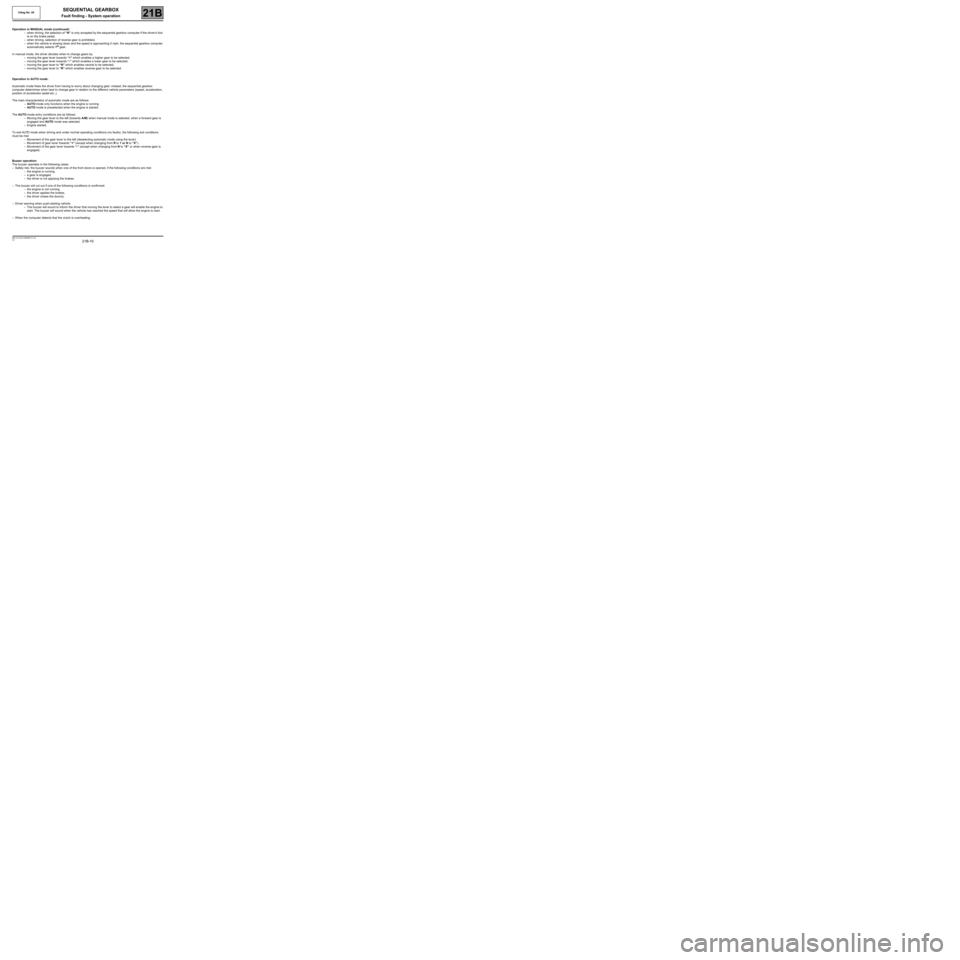
21B-10
MR-413-X44-21B000$177.mif
V2
Vdiag No: 04SEQUENTIAL GEARBOX
Fault finding - System operation21B
Operation in MANUAL mode (continued):
–when driving, the selection of “N” is only accepted by the sequential gearbox computer if the driver's foot
is on the brake pedal,
–when driving, selection of reverse gear is prohibited,
–when the vehicle is slowing down and the speed is approaching 0 mph, the sequential gearbox computer
automatically selects 1
st gear.
In manual mode, the driver decides when to change gears by:
–moving the gear lever towards “+” which enables a higher gear to be selected,
–moving the gear lever towards “-” which enables a lower gear to be selected,
–moving the gear lever to “N” which enables neutral to be selected,
–moving the gear lever to “R” which enables reverse gear to be selected.
Operation in AUTO mode:
Automatic mode frees the driver from having to worry about changing gear: instead, the sequential gearbox
computer determines when best to change gear in relation to the different vehicle parameters (speed, acceleration,
position of accelerator pedal etc.,).
The main characteristics of automatic mode are as follows:
–AUTO mode only functions when the engine is running.
–AUTO mode is preselected when the engine is started.
The AUTO mode entry conditions are as follows:
–Moving the gear lever to the left (towards A/M) when manual mode is selected, when a forward gear is
engaged and AUTO mode was selected.
–Engine started.
To exit AUTO mode when driving and under normal operating conditions (no faults), the following exit conditions
must be met:
–Movement of the gear lever to the left (deselecting automatic mode using the lever).
–Movement of gear lever towards “+” (except when changing from R to 1 or N to “X”).
–Movement of the gear lever towards “-” (except when changing from N to “X” or when reverse gear is
engaged).
Buzzer operation:
The buzzer operates in the following cases:
–Safety risk: the buzzer sounds when one of the front doors is opened, if the following conditions are met:
–the engine is running,
–a gear is engaged,
–the driver is not applying the brakes.
–The buzzer will cut out if one of the following conditions is confirmed:
–the engine is not running,
–the driver applies the brakes,
–the driver closes the door(s).
–Driver warning when push-starting vehicle:
–The buzzer will sound to inform the driver that moving the lever to select a gear will enable the engine to
start. The buzzer will sound when the vehicle has reached the speed that will allow the engine to start.
–When the computer detects that the clutch is overheating.
Page 12 of 138

21B-12
MR-413-X44-21B000$177.mif
V2
Vdiag No: 04SEQUENTIAL GEARBOX
Fault finding - System operation21B
Depress brake pedal symbol:
–The “depress brake” symbol lights up when there is:
–a request to change gear when stopped without the brake pedal applied,
–a request to start the engine with gear engaged without brake pedal applied,
–a request to select N when driving without brake pedal applied,
–a request to select AUTO, with the vehicle stationary, the engine running and 2
nd gear engaged.
–Depress brake pedal symbol goes out:
The symbol goes out if the driver depresses the brake pedal or after a delay.
In the event that the driver makes a request causing the gear requested to flash and the symbol to be displayed at
the same time, they will be synchronised and last for the same period of time.
Fault warning light:
This warning light comes on when a fault is detected by the sequential gearbox computer.Note:
If, while the symbol is lit, the driver depresses the brake pedal, the symbol will go out and the display will return to
its previous status (the lever request is not registered).
Page 16 of 138

21B-16
MR-413-X44-21B000$236.mif
V2
Vdiag No: 04SEQUENTIAL GEARBOX
Fault finding - Replacement of components21B
GEARBOX - HYDRAULIC UNIT KIT (without clutch)
A) Switch on the ignition.
Clear the computer fault memory using command RZ001 Stored fault(s).
B) Rehabilitate the hydraulic unit using command AC007 "Hydraulic unit pump rehabilitation".
Bleed the hydraulic circuit.
Gearbox in neutral, engine speed zero, handbrake engaged and no fault with the solenoid valves and the
master slave sensors.
Bleed the hydraulic pressure unit using command AC011 Bleed hydraulic pressure unit.
Wait for the procedure to end.
Repeat the procedure if unsuccessful.
C) Bleed the clutch hydraulic circuit using command AC008 "Clutch circuit phase 1 bleed".
Wait for the procedure to end (this should take 6 minutes).
D) Bleed the clutch hydraulic circuit using command AC009 "Clutch circuit phase 2 bleed".
Wait for the procedure to end (this should take 8 minutes).
E) In order for the following steps to run smoothly, check that parameter PR145 "Engine coolant temperature" is
below 50 ˚C.
Clear all programming using commands:
–RZ002 Programming,
–RZ003 Program biting point,
–RZ008 Initial closed position of clutch.
Exit fault finding mode and switch off the ignition.
Wait 1 minute and then re-establish dialogue with the computer.
F) Program the gears using command VP008 "Programming selection/engagement zones".
Wait for the procedure to end.
Exit fault finding mode and switch off the ignition.
Wait 1 minute and then re-establish dialogue with the computer.
Check that programming has been successful by referring to the following status:
ET061 “Gear programming” displays “DONE”.
Brake and select all the gears in the gearbox, while checking that they are recognised on the display. Repeat
procedure G if not done. WARNING
For all operations on the hydraulic circuit, activate commands AC006 "Hydraulic unit pump inhibition"
and AC081 "Discharge pressure accumulator" until the hydraulic pressure PR018 “Hydraulic pressure” is
close to zero.
Page 18 of 138
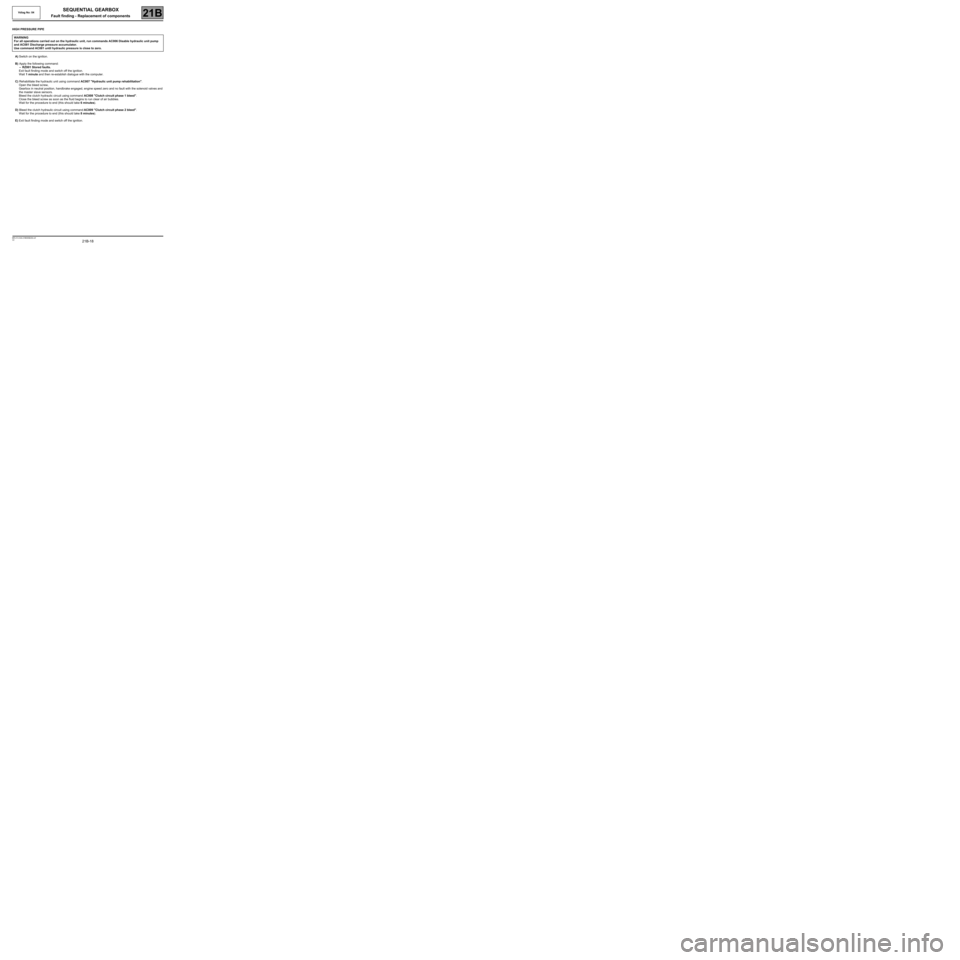
21B-18
MR-413-X44-21B000$236.mif
V2
Vdiag No: 04SEQUENTIAL GEARBOX
Fault finding - Replacement of components21B
HIGH PRESSURE PIPE
A) Switch on the ignition.
B) Apply the following command:
–RZ001 Stored faults.
Exit fault finding mode and switch off the ignition.
Wait 1 minute and then re-establish dialogue with the computer.
C) Rehabilitate the hydraulic unit using command AC007 "Hydraulic unit pump rehabilitation".
Open the bleed screw,
Gearbox in neutral position, handbrake engaged, engine speed zero and no fault with the solenoid valves and
the master slave sensors.
Bleed the clutch hydraulic circuit using command AC008 "Clutch circuit phase 1 bleed".
Close the bleed screw as soon as the fluid begins to run clear of air bubbles.
Wait for the procedure to end (this should take 6 minutes).
D) Bleed the clutch hydraulic circuit using command AC009 "Clutch circuit phase 2 bleed".
Wait for the procedure to end (this should take 8 minutes).
E) Exit fault finding mode and switch off the ignition. WARNING
For all operations carried out on the hydraulic unit, run commands AC006 Disable hydraulic unit pump
and AC081 Discharge pressure accumulator.
Use command AC081 until hydraulic pressure is close to zero.
Page 19 of 138
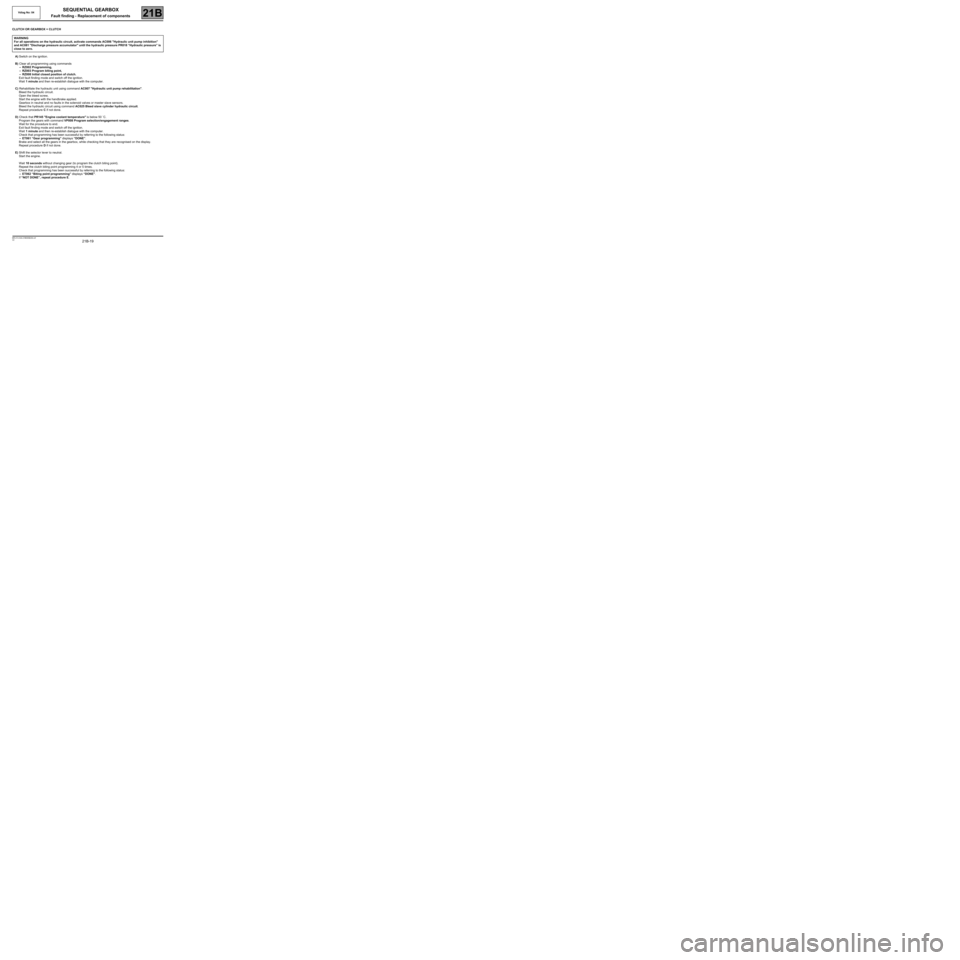
21B-19
MR-413-X44-21B000$236.mif
V2
Vdiag No: 04SEQUENTIAL GEARBOX
Fault finding - Replacement of components21B
CLUTCH OR GEARBOX + CLUTCH
A) Switch on the ignition.
B) Clear all programming using commands
–RZ002 Programming,
–RZ003 Program biting point,
–RZ008 Initial closed position of clutch.
Exit fault finding mode and switch off the ignition.
Wait 1 minute and then re-establish dialogue with the computer.
C) Rehabilitate the hydraulic unit using command AC007 "Hydraulic unit pump rehabilitation".
Bleed the hydraulic circuit.
Open the bleed screw,
Start the engine with the handbrake applied.
Gearbox in neutral and no faults in the solenoid valves or master slave sensors.
Bleed the hydraulic circuit using command AC025 Bleed slave cylinder hydraulic circuit.
Repeat procedure C if not done.
D) Check that PR145 "Engine coolant temperature" is below 50 ˚C.
Program the gears with command VP008 Program selection/engagement ranges.
Wait for the procedure to end.
Exit fault finding mode and switch off the ignition.
Wait 1 minute and then re-establish dialogue with the computer.
Check that programming has been successful by referring to the following status:
–ET061 “Gear programming” displays “DONE”.
Brake and select all the gears in the gearbox, while checking that they are recognised on the display.
Repeat procedure D if not done.
E) Shift the selector lever to neutral.
Start the engine.
Wait 10 seconds without changing gear (to program the clutch biting point).
Repeat the clutch biting point programming 4 or 5 times.
Check that programming has been successful by referring to the following status:
–ET062 “Biting point programming” displays “DONE”.
If “NOT DONE”, repeat procedure E. WARNING
For all operations on the hydraulic circuit, activate commands AC006 "Hydraulic unit pump inhibition"
and AC081 "Discharge pressure accumulator" until the hydraulic pressure PR018 “Hydraulic pressure” is
close to zero.
Page 24 of 138

21B-24
MR-413-X44-21B000$413.mif
V2
21B
SEQUENTIAL GEARBOX
Fault finding - Interpretation of faults
DF002
PRESENT
OR
STOREDCOMPUTER
1.DEF: Internal electronic fault
NOTESSpecial note:
–fault warning light comes on.
Use the Wiring Diagrams Technical Note for New TWINGO.
Check the condition and positioning of the following fuses:
●Fuse F1 (30A) located in the engine fuse and relay box.
●Fuses F16 (20A) and F4 (7.5A) located in the passenger compartment fuse box.
Check the connection and condition of the 52-track connector of component 119.
If the connector is faulty and there is a repair procedure (see Technical Note 6015A, Electrical wiring repair,
Wiring: Precautions for repair), repair the connector, otherwise replace the wiring.
Check for + before ignition on connection BP39 and for + after ignition feed on connection AP4 on the
connector of component 119.
If the connection(s) are faulty and there is a repair method (see Technical Note 6015A, Repairing electrical
wiring, W iring: Precautions for repair), repair the wiring, otherwise replace it.
Check the insulation, continuity and the absence of interference resistance on the following connections:
●Connection code N between component 119 and the chassis earth MC - 12A.
●Connection code N between component 119 and the chassis earth MC - 12B.
If the connection(s) are faulty and there is a repair method (see Technical Note 6015A, Repairing electrical
wiring, W iring: Precautions for repair), repair the wiring, otherwise replace it.
Clear the computer fault memory and exit fault finding.
Switch off the ignition.
Switch on the ignition again and carry out a new check using the diagnostic tool.
If the fault is still present, contact the Techline.
AFTER REPAIRDeal with any faults displayed by the diagnostic tool.
Clear the computer memory.
Carry out a road test followed by another check with the diagnostic tool.
BVRJH1_V04_DF002
MR-413-X44-21B000$413.mif
Vdiag No.: 04
Page 25 of 138

21B-25
MR-413-X44-21B000$413.mif
V2
SEQUENTIAL GEARBOX
Fault finding - Interpretation of faults
Vdiag No.: 04
21B
DF039
PRESENT
OR
STOREDENGINE SPEED SIGNAL
1.DEF: Signal incoherent
2.DEF: No signal
NOTESConditions for applying the fault finding procedure to stored faults:
The fault is declared present after the engine starts.
Special note:
Fault warning light comes on.
Use the Wiring Diagrams Technical Note for New TWINGO.
1.DEF
NOTESNone.
Engine running at idle speed and vehicle stopped, check the gearbox input engine speed sensor and the engine
speed sensor are operating correctly using the following parameters:
●PR006 Engine speed,
●PR014 "Gearbox input speed".
Check the mechanical condition of the clutch.
2.DEF
NOTESNone.
Check the connection and condition of the connectors of components 119 and 120.
If the connector(s) are faulty and if there is a repair method (see Technical Note 6015A, Repairing electrical
wiring, W iring: Precautions for repair), repair the connectors; otherwise, replace the wiring.
Check the insulation, continuity and absence of interference resistance on the following connection:
●Connection code H7 between components 119 and 120.
If the connection is faulty and if there is a repair procedure (see Technical Note 6015A, Electrical wiring repair,
Wiring: Precautions for repair), repair the wiring, otherwise replace the wiring.
Check the injection system (see 17B, Petrol injection) and deal with any faults.
If the fault is still present, contact the Techline.
AFTER REPAIRDeal with any faults displayed by the diagnostic tool.
Clear the computer memory.
Carry out a road test followed by another check with the diagnostic tool.
BVRJH1_V04_DF039
Page 26 of 138
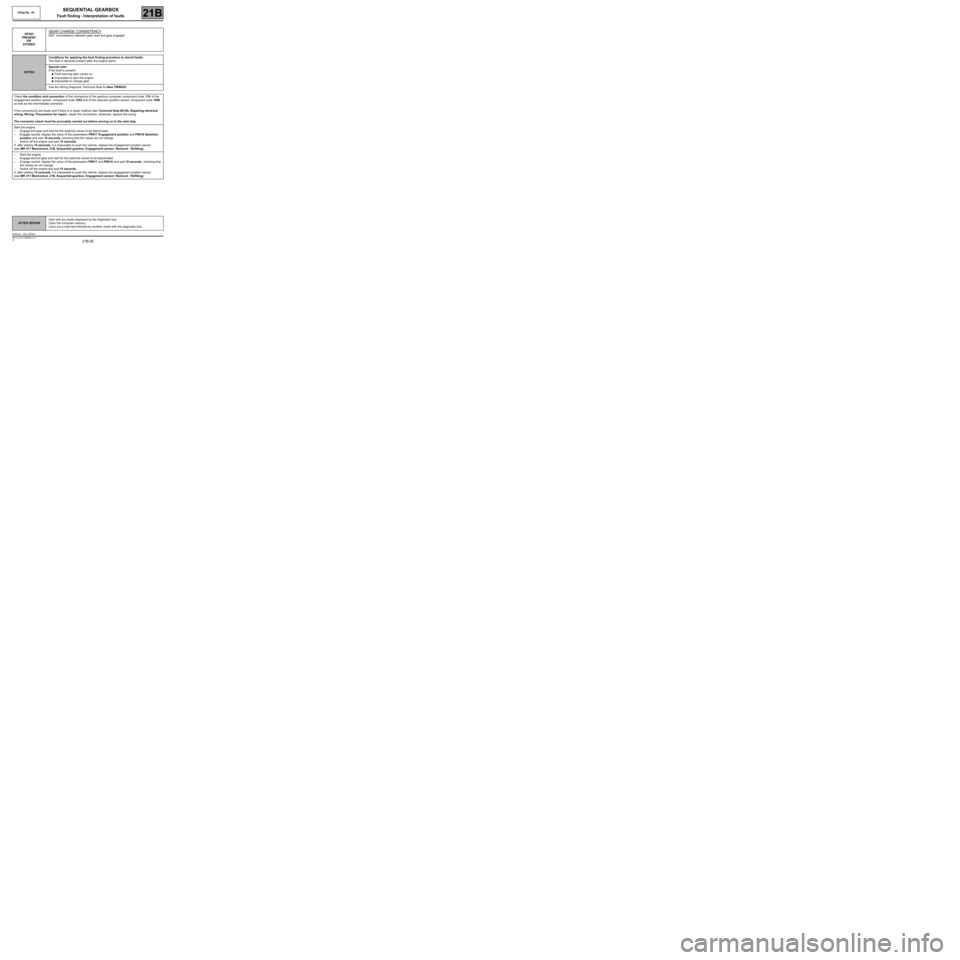
21B-26
MR-413-X44-21B000$413.mif
V2
SEQUENTIAL GEARBOX
Fault finding - Interpretation of faults
Vdiag No.: 04
21B
DF043
PRESENT
OR
STOREDGEAR CHANGE CONSISTENCY
DEF: Inconsistency between gear read and gear engaged
NOTESConditions for applying the fault finding procedure to stored faults:
The fault is declared present after the engine starts.
Special note:
If the fault is present:●Fault warning light comes on.
●Impossible to start the engine.
●Impossible to change gear.
Use the Wiring Diagrams Technical Note for New TWINGO.
Check the condition and connection of the connectors of the gearbox computer, component code 119, of the
engagement position sensor, component code 1055 and of the selection position sensor, component code 1056
as well as the intermediate connector.
If the connector(s) are faulty and if there is a repair method (see Technical Note 6015A, Repairing electrical
wiring, W iring: Precautions for repair), repair the connectors; otherwise, replace the wiring.
The connector check must be accurately carried out before moving on to the next step.
Start the engine.
–Engage first gear and wait for the solenoid valves to be deactivated.
–Engage neutral, display the value of the parameters PR017 Engagement position and PR016 Selection
position and wait 10 seconds, checking that the values do not change.
–Switch off the engine and wait 15 seconds.
If, after waiting 15 seconds, it is impossible to push the vehicle, replace the engagement position sensor
(see MR 411 Mechanical, 21B, Sequential gearbox, Engagement sensor: Removal - Refitting).
–Start the engine.
–Engage second gear and wait for the solenoid valves to be deactivated.
–Engage neutral, display the value of the parameters PR017 and PR016 and wait 10 seconds, checking that
the values do not change.
–Switch off the engine and wait 15 seconds.
If, after waiting 15 seconds, it is impossible to push the vehicle, replace the engagement position sensor
(see MR 411 Mechanical, 21B, Sequential gearbox, Engagement sensor: Removal - Refitting).
AFTER REPAIRDeal with any faults displayed by the diagnostic tool.
Clear the computer memory.
Carry out a road test followed by another check with the diagnostic tool.
BVRJH1_V04_DF043
Page 31 of 138
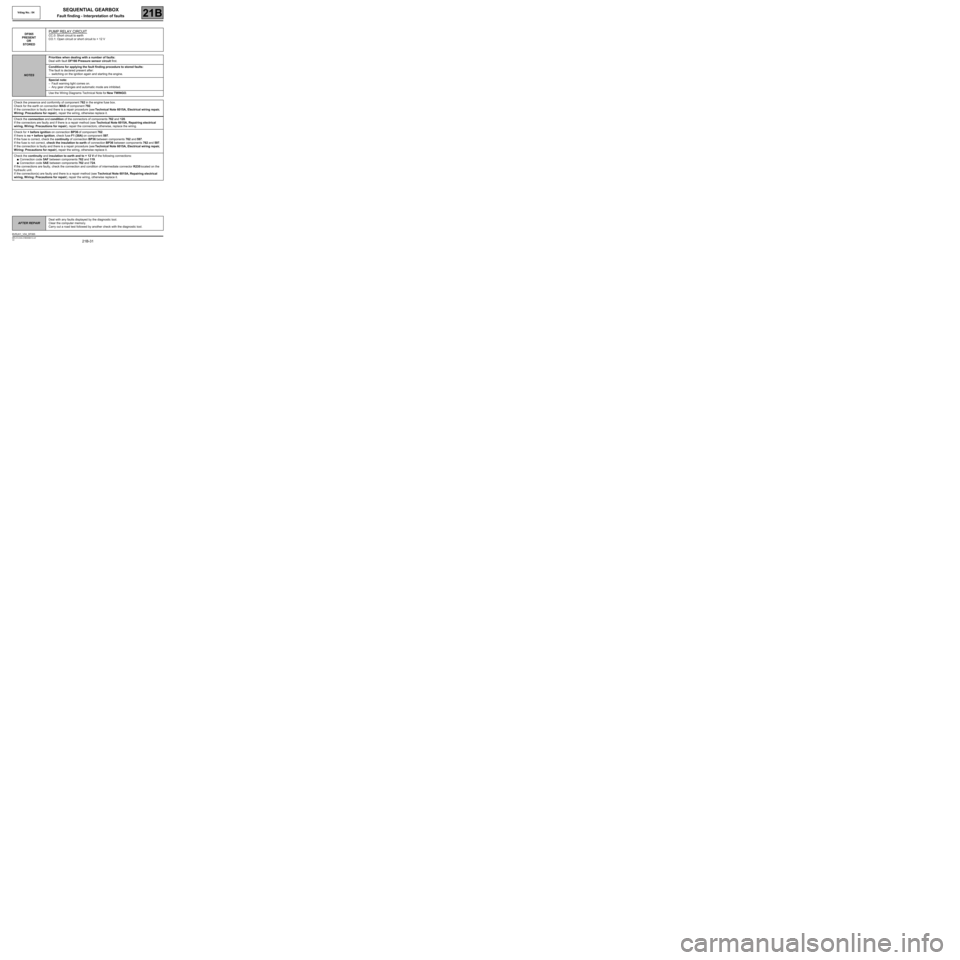
21B-31
MR-413-X44-21B000$413.mif
V2
SEQUENTIAL GEARBOX
Fault finding - Interpretation of faults
Vdiag No.: 04
21B
DF065
PRESENT
OR
STOREDPUMP RELAY CIRCUIT
CC.0: Short circuit to earth
CO.1: Open circuit or short circuit to + 12 V
NOTESPriorities when dealing with a number of faults:
Deal with fault DF166 Pressure sensor circuit first.
Conditions for applying the fault finding procedure to stored faults:
The fault is declared present after:
–switching on the ignition again and starting the engine.
Special note:
–Fault warning light comes on.
–Any gear changes and automatic mode are inhibited.
Use the Wiring Diagrams Technical Note for New TWINGO.
Check the presence and conformity of component 762 in the engine fuse box.
Check for the earth on connection MAS of component 792.
If the connection is faulty and there is a repair procedure (see Technical Note 6015A, Electrical wiring repair,
Wiring: Precautions for repair), repair the wiring, otherwise replace it.
Check the connection and condition of the connectors of components 762 and 120.
If the connectors are faulty and if there is a repair method (see Technical Note 6015A, Repairing electrical
wiring, W iring: Precautions for repair), repair the connectors; otherwise, replace the wiring.
Check for + before ignition on connection BP36 of component 762.
If there is no + before ignition, check fuse F1 (30A) on component 597.
If the fuse is correct, check the continuity of connection BP36 between components 762 and 597.
If the fuse is not correct, check the insulation to earth of connection BP36 between components 762 and 597.
If the connection is faulty and there is a repair procedure (see Technical Note 6015A, Electrical wiring repair,
Wiring: Precautions for repair), repair the wiring, otherwise replace it.
Check the continuity and insulation to earth and to + 12 V of the following connections:
●Connection code 5AF between components 762 and 119.
●Connection code 5AE between components 762 and 724.
If the connections are faulty, check the connection and condition of intermediate connector R235 located on the
hydraulic unit.
If the connection(s) are faulty and there is a repair method (see Technical Note 6015A, Repairing electrical
wiring, W iring: Precautions for repair), repair the wiring, otherwise replace it.
AFTER REPAIRDeal with any faults displayed by the diagnostic tool.
Clear the computer memory.
Carry out a road test followed by another check with the diagnostic tool.
BVRJH1_V04_DF065